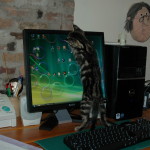 I saved cats for last in this series on instinctive drift in companion animals because they occupy a unique niche in the domesticated species line-up. That unique niche, in turn, owes its existence to behaviors that make cats anything but little dogs or fur-covered humanoids. Add that they’re the most recent addition to the self-domesticated/domesticated population and it’s no surprise that cats may drift more readily toward their deeply entrenched behaviors, some or many of which may confound any humans, canines, or members of other domestic species with whom the cats interact. In fact many of the behaviors that more aileurophobic folks find annoying or even frightening are evidence of the cat’s high degree of driftability. (I know that’s not a word, but you get the idea.)
I saved cats for last in this series on instinctive drift in companion animals because they occupy a unique niche in the domesticated species line-up. That unique niche, in turn, owes its existence to behaviors that make cats anything but little dogs or fur-covered humanoids. Add that they’re the most recent addition to the self-domesticated/domesticated population and it’s no surprise that cats may drift more readily toward their deeply entrenched behaviors, some or many of which may confound any humans, canines, or members of other domestic species with whom the cats interact. In fact many of the behaviors that more aileurophobic folks find annoying or even frightening are evidence of the cat’s high degree of driftability. (I know that’s not a word, but you get the idea.)

The cat who walks alone.
Heading the list, cats are the only naturally solitary and nocturnal animal in the domestic line-up, two behaviors essential for the survival of a small predator preyed on by members of other species. But unlike the free-roaming dogs I wrote about last month who trade in the social orientation of group hunters like wolves and wild dogs for a more solitary one when their survival depends on hunting small game or scavenging, the role of solitary predator is the norm in the small wildcat behavioral database. In domestic cats, it’s the more social behaviors that evolved later when feline survival meant tolerating the presence of other cats, humans, and other domestic animals.
Examples of drifting back to solitary orientations occur fairly often in companion cats. For some cats, a move to a new home or the introduction of a new piece object, animal or person in the household may cause them to vanish. Or rather they’ll vanish relative to any diurnal occupants. Those in this group often simultaneously drift to their more nocturnal orientation and emerge after dark to explore and sometimes scent mark the new location or addition when any human and canine residents are sleeping.
Cats also may retreat to the farthest corner under the bed or in a little used closet if they experience injury or illness. At such times, they just want to be left alone. While such behavior may help them conserve energy and protect them from predators in the wild, it can complicate matters enormously for their human caregivers. It’s at such times that people discover that the same cats who take up so much room so obviously when they feel fit may disappear into the smallest nooks and crannies when they revert to solitary mode. As feline veterinarian and author Louis Camuti once remarked, a cat who doesn’t want to be found can fold himself up like a pocket handkerchief!
Drifts toward the strong feline territorial nature that enhances the survival of small wildcats may combine with their solitary and nocturnal natures to create breakdowns in human-feline communication. During the early spring to early summer and from late summer through fall when there’s much more activity in the free-roaming domestic cat and more nocturnal wildlife populations, some house cats may become more nocturnal. Instead of sleeping the night away in their feline or human beds, these animals patrol the house. Depending on what they see, hear, or smell outdoors they may vocalize or mark, which may awaken their owners. Other cats may work up an appetite during these late night patrols and pester their sleeping caregivers for a snack or early breakfast. People who give into these feline pleas often rue the day they did when it causes the behavior to become a feline habit!
As far as drifting toward predatory behavior goes, the bulk of what most of us consider playing with cats elicits responses that mimic part or all of the feline predatory sequence: stalk, pounce, pinion with claws, kill, eat. But if folks inadvertently feed too much stimulation into the play or abort the play mid-sequence, some of these cats may drift across the line from play into predatory displays in an attempt to complete it. Problematic behaviors associated with this include cats who go form holding people’s hands with their teeth and paws to puncturing the skin and raking it with claws. Cats stimulated with string or yarn games may complete the sequence by eating the string or yarn and suffer the serious medical problems associated with this. Those whose owners’ abort laser games that rile their cats up into full predatory mode who don’t provide the animals with solid targets into which to sink their teeth at the end of the game may turn their pets into compulsive shadow chasers.
Then we have cases like the one pictured here in which cats attack moving objects, the movement of which we may be unaware of until too late. In this case, I caught Bamboo attacking the moving bubbles on my computer’s screen-saver before he did any damage. But I no longer use this screen-saver for obvious reasons! Similarly those whose cats are stimulated by curtains or houseplants waving in the breeze of an open window may need to remove these objects or somehow cat-proof them. For cats who routinely get into this kind of trouble out of boredom, safe environmental enrichment is the best answer.
unaware of until too late. In this case, I caught Bamboo attacking the moving bubbles on my computer’s screen-saver before he did any damage. But I no longer use this screen-saver for obvious reasons! Similarly those whose cats are stimulated by curtains or houseplants waving in the breeze of an open window may need to remove these objects or somehow cat-proof them. For cats who routinely get into this kind of trouble out of boredom, safe environmental enrichment is the best answer.
Like other solitary species, cats evolved complex courting, mating, and parental rituals to ensure their own survival and that of their offspring. Prior to copulation (i.e., sexual contact of a male with a receptive female), a male may grasp the female by the scruff of the neck and slide his body down her multiple times in an attempt to properly position himself. When the act is completed, females may lash out at the males with claws unsheathed. In the drifting version, rhythmic head-to-base-of-tail human petting will cause some cats to grab the person’s hand (often the fleshy part at the base of the thumb) with teeth and hold the wrist with paws. If the person is sitting or lying down, the cat also may press the hind paws against the person’s forearm.
What happens next depends on the person. If no more stimulus is fed into the process, most cats eventually will disengage and wander off. But if the person panics and yells at or hits the cat fearing the cat might bite, he or she will get a painful lesson in exactly how thin the line between normal sexual and predatory behavior can be. Instead of merely holding with teeth and paws, the cat will dig in with teeth and claws on all four feet so fast it’s easy to accuse the cat of having a “psychotic episode”. At that point those in the process of learning this feline lesson also will get another reminder of the relationship between stimulus input and the amount of energy animals will put into aggressive displays: the more stimulation, the more energy. Screaming and hitting the cat will only cause the cat to dig in more. On the upside, it’s another one of those human-animal experiences that inspires most people to learn more about normal animal behavior.
 Unfortunately though, some people enjoy interacting with cats in ways that incite aggressive feline responses. I assume they consider this fun or even evidence of their machismo, but it seems more like a aileurophobic response to me. While it seems like anyone who gets bitten or scratched doing this deserves it, that’s not the case of those unsuspecting people who reach out to pet these cats and inadvertently trigger a defensive feline aggressive response thanks to this kind of “play”.
Unfortunately though, some people enjoy interacting with cats in ways that incite aggressive feline responses. I assume they consider this fun or even evidence of their machismo, but it seems more like a aileurophobic response to me. While it seems like anyone who gets bitten or scratched doing this deserves it, that’s not the case of those unsuspecting people who reach out to pet these cats and inadvertently trigger a defensive feline aggressive response thanks to this kind of “play”.
Granted the domestic cat’s ability to revert to the most basic feline behavior repertoire so quickly sometimes creates problems for us humans. On the other hand, it serves as a reminder of how energy-efficient and elegant these unique creatures in the domestic animal lineup really are.
The cat who walks alone.
Heading the list, cats are the only naturally solitary and nocturnal animal in the domestic line-up, two behaviors essential for the survival of a small predator preyed on by members of other species. But unlike the free-roaming dogs I wrote about last month who trade in the social orientation of group hunters like wolves and wild dogs for a more solitary one when their survival depends on hunting small game or scavenging, the role of solitary predator is the norm in the small wildcat behavioral database. In domestic cats, it’s the more social behaviors that evolved later when feline survival meant tolerating the presence of other cats, humans, and other domestic animals.
Examples of drifting back to solitary orientations occur fairly often in companion cats. For some cats, a move to a new home or the introduction of a new piece object, animal or person in the household may cause them to vanish. Or rather they’ll vanish relative to any diurnal occupants. Those in this group often simultaneously drift to their more nocturnal orientation and emerge after dark to explore and sometimes scent mark the new location or addition when any human and canine residents are sleeping.
Cats also may retreat to the farthest corner under the bed or in a little used closet if they experience injury or illness. At such times, they just want to be left alone. While such behavior may help them conserve energy and protect them from predators in the wild, it can complicate matters enormously for their human caregivers. It’s at such times that people discover that the same cats who take up so much room so obviously when they feel fit may disappear into the smallest nooks and crannies when they revert to solitary mode. As feline veterinarian and author Louis Camuti once remarked, a cat who doesn’t want to be found can fold himself up like a pocket handkerchief!
Drifts toward the strong feline territorial nature that enhances the survival of small wildcats may combine with their solitary and nocturnal natures to create breakdowns in human-feline communication. During the early spring to early summer and from late summer through fall when there’s much more activity in the free-roaming domestic cat and more nocturnal wildlife populations, some house cats may become more nocturnal. Instead of sleeping the night away in their feline or human beds, these animals patrol the house. Depending on what they see, hear, or smell outdoors they may vocalize or mark, which may awaken their owners. Other cats may work up an appetite during these late night patrols and pester their sleeping caregivers for a snack or early breakfast. People who give into these feline pleas often rue the day they did when it causes the behavior to become a feline habit!
As far as drifting toward predatory behavior goes, the bulk of what most of us consider playing with cats elicits responses that mimic part or all of the feline predatory sequence: stalk, pounce, pinion with claws, kill, eat. But if folks inadvertently feed too much stimulation into the play or abort the play mid-sequence, some of these cats may drift across the line from play into predatory displays in an attempt to complete it. Problematic behaviors associated with this include cats who go form holding people’s hands with their teeth and paws to puncturing the skin and raking it with claws. Cats stimulated with string or yarn games may complete the sequence by eating the string or yarn and suffer the serious medical problems associated with this. Those whose owners’ abort laser games that rile their cats up into full predatory mode who don’t provide the animals with solid targets into which to sink their teeth at the end of the game may turn their pets into compulsive shadow chasers.
Then we have cases like the one pictured here in which cats attack moving objects, the movement of which we may be unaware of until too late. In this case, I caught Bamboo attacking the moving bubbles on my computer’s screen-saver before he did any damage. But I no longer use this screen-saver for obvious reasons! Similarly those whose cats are stimulated by curtains or houseplants waving in the breeze of an open window may need to remove these objects or somehow cat-proof them. For cats who routinely get into this kind of trouble out of boredom, safe environmental enrichment is the best answer.
unaware of until too late. In this case, I caught Bamboo attacking the moving bubbles on my computer’s screen-saver before he did any damage. But I no longer use this screen-saver for obvious reasons! Similarly those whose cats are stimulated by curtains or houseplants waving in the breeze of an open window may need to remove these objects or somehow cat-proof them. For cats who routinely get into this kind of trouble out of boredom, safe environmental enrichment is the best answer.
Like other solitary species, cats evolved complex courting, mating, and parental rituals to ensure their own survival and that of their offspring. Prior to copulation (i.e., sexual contact of a male with a receptive female), a male may grasp the female by the scruff of the neck and slide his body down her multiple times in an attempt to properly position himself. When the act is completed, females may lash out at the males with claws unsheathed. In the drifting version, rhythmic head-to-base-of-tail human petting will cause some cats to grab the person’s hand (often the fleshy part at the base of the thumb) with teeth and hold the wrist with paws. If the person is sitting or lying down, the cat also may press the hind paws against the person’s forearm.
What happens next depends on the person. If no more stimulus is fed into the process, most cats eventually will disengage and wander off. But if the person panics and yells at or hits the cat fearing the cat might bite, he or she will get a painful lesson in exactly how thin the line between normal sexual and predatory behavior can be. Instead of merely holding with teeth and paws, the cat will dig in with teeth and claws on all four feet so fast it’s easy to accuse the cat of having a “psychotic episode”. At that point those in the process of learning this feline lesson also will get another reminder of the relationship between stimulus input and the amount of energy animals will put into aggressive displays: the more stimulation, the more energy. Screaming and hitting the cat will only cause the cat to dig in more. On the upside, it’s another one of those human-animal experiences that inspires most people to learn more about normal animal behavior.
Granted the domestic cat’s ability to revert to the most basic feline behavior repertoire so quickly sometimes creates problems for us humans. On the other hand, it serves as a reminder of how energy-efficient and elegant these unique creatures in the domestic animal lineup really are.